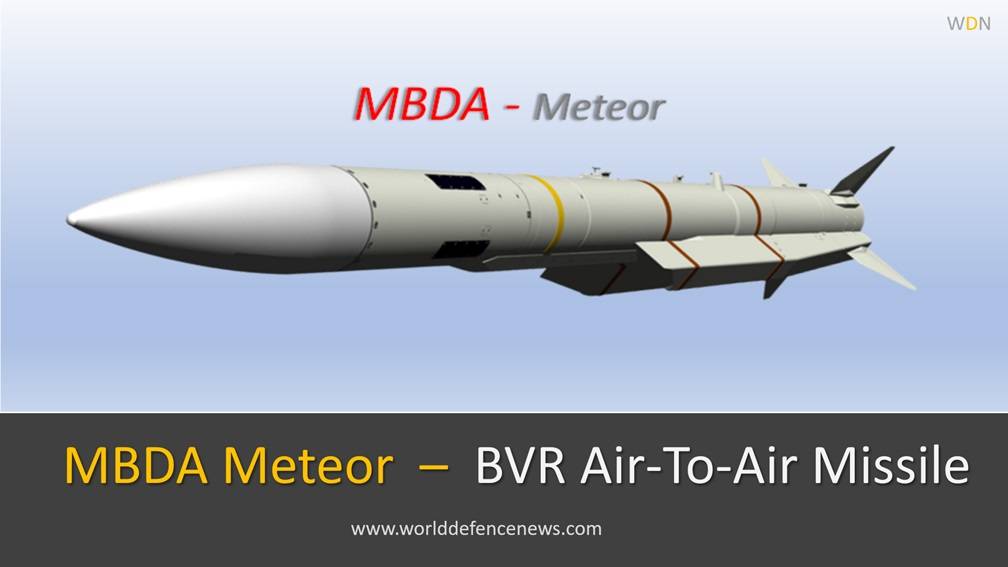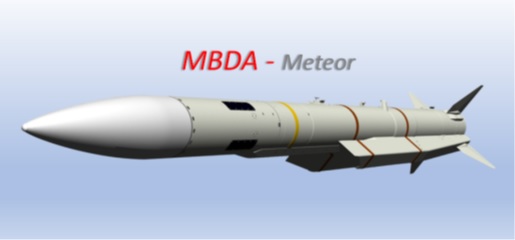
Meteor Missile
Latest BVR Air-To-Air Meteor Missile By MBDA
The meteor missile is the latest air dominance and air-superiority combat missile developed and manufactured by MBDA Systems. It is an active radar-guided, beyond visual range air-to-air missile (BVRAAM) system.
The Meteor missile offers a unique multi-shot capability that allows the pilot to simultaneously engage multiple targets. It has a highly advanced seeker which provides the ability to lock-on and engage highly maneuverable targets.
The MBDA meteor missile can be effectively used to neutralize and shoot down highly maneuverable wide range of targets, such as UAV’s, cruise missiles and fighter jets. It is found to be equally effective against small targets such as unmanned aerial vehicles (UAV).
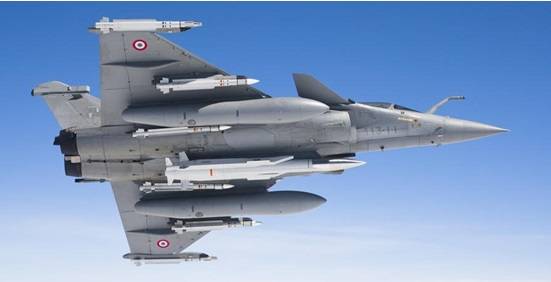
A Meteor missile is a complete game changes in air combat. It is very difficult to jam the missile. It can hit the targets in a heavy electronic countermeasures (ECM) environment. It has a no-escape zone of 60 km and a maximum range of over 200 kilometers.
The Meteor is a part of the standard weapons package as the BVR air-to-air missile for European fighter jets such as the Dassault Rafale , Eurofighter Typhon and Swedish Saab Gripen. Meteor would soon be integrated on F-35 Lightening Strike used by German and Royal Air Force of UK.
Meteor Missile General Features
Meteor Missile | |
Missile Type | Air-To-Air BVR Missile |
Manufactured By | MBDA Systems |
Unit Weight | 190 kg , ( 419 lb ) |
Missile Length | 3.65 Meters , ( 12 ft 0 inch ) |
Missile Diameter | 17.8 cm , ( 7.0 inch ) |
Unit cost | € 2,000,000 ( 2019 ) |
Warhead | High Explosive Blast-Fragmentation |
Detonation Mechanism | Duel Fuse - Proximity And Impact |
Engine | Throttleable Ducted Rocket ( Ramjet ) |
Operational Range | 200 Km |
No Escape Zone | 60 Km |
Guidance System | Inertial Guidance, Mid-course Update via Two-Way Datalink, Terminal Active Radar Homing |
Maximum Speed | Over Mach 4 |
Meteor Missile Two-Way Data Link
The Meteor missile is powered by a solid-fueled ramjet motor that allows the missile to cruise at a speed of over Mach 4. The ramjet motor provides the missile with the required thrust and mid-course acceleration to effectively chase and intercept the target.
The two-way data link is another crucial feature of the meteor missile. It allows the pilot to track the course of the missile after it is fired. With encrypted data-link the pilot can direct the missile with precision and perform mid-course target updates or retargeting the missile to the new target.
Meteor Missile Advanced Features
The Meteor missile, according to MBDA, has three to six times the kinetic performance of contemporary air-to-air missiles with comparable BVR capabilities. Another lethal feature of the meteor missile is the dual-fuse.
The meteor missile has both proximity and impact fuses, which increases the kill probability significantly. It also increases the destructive power and dependability.

Development History Of Meteor Missile
The Meteor Missile has been jointly developed by a consortium of six European countries and MBDA Systems. MBDA is a multinational group and a world leader in missile systems with manufacturing facilities in France, the United Kingdom, Italy, Germany, and the United States.
The Meteor missile project was first initiated by the UK’s Ministry of Defence. The group of other five European countries also joined the project, which includes Germany, Italy, Spain, France, and Sweden, to fulfil their future BVRAAM requirements.
The UK Ministry of Defence (MoD) awarded a contract to MBDA for the design and development of the Meteor missile on behalf of all six partner European countries. The Meteor was first integrated into Gripen and Rafale aircraft for an initial trial run.
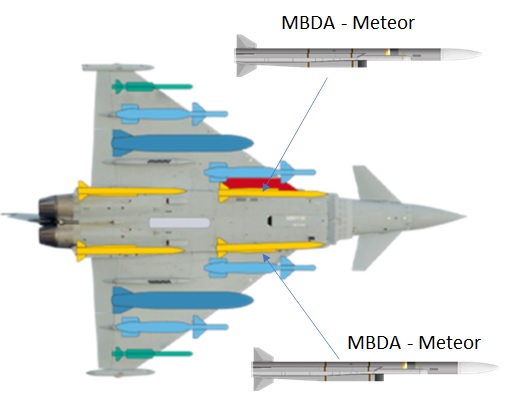
However, the Eurofighter Typhoon fighter jet became the first fighter jet to successfully test launch the missile. Later on, the meteor was also successfully test launched from the Saab Gripen and Dassault Rafale.
The Meteor missile was fully integrated into the Swedish Gripen fighter aircraft. The Gripen fighter jet became the first combat aircraft in the world to make the Meteor BVRAAM missile fully operational.
In response to rising demand, BAE Systems began work to integrate and operationalize the MBDA meteor on the F-35 Lightening II Joint Strike Fighter Jets used by the German and Royal Air Forces of the United Kingdom.
Meteor Missile Design Features
The Meteor is designed as a complete item that requires no further assembly or maintenance. This enables missiles to be quickly mounted and deployed on the selected platform. This results in significant reductions in inventory management and logistical support costs.
It has outstanding stealth features that add to its lethality. The stealth qualities make initiating and deploying countermeasures extremely difficult for the target aircraft. Furthermore, because it is a stealth missile, the target aircraft has little time to undertake any evasive manoeuvres.
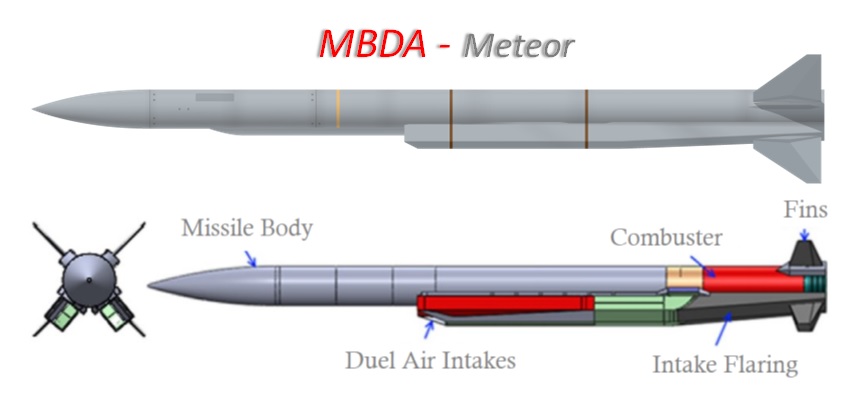
It has advanced kinematics features, making the missile highly manoeuvrable. It is capable of shooting down a wide variety of various targets. Meteor is unaffected by weather conditions because it is all-weather.
Meteor Ramjet Engine And Propulsion System
The Meteor missile is propelled by a solid-fuel ramjet rocket produced by Bayern-Chemie. The ramjet engine provides the Meteor missile with the necessary propulsive power to launch and engage long-range targets beyond visual range.
The missile’s ramjet engine has the unique ability to accelerate and decelerate in response to target movement. This allows the missile to conserve fuel while gaining the speed required to chase and destroy rapidly moving, highly maneuverable targets.
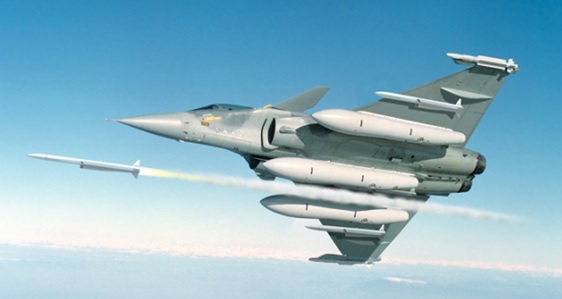
The missile has an electronics and propulsion control unit (EPCU). The dual air intake and EPCU control the engine’s air intake and duct coverings based on the cruising speed and altitude of the target.
The EPCU system is a critical component of the missile that monitors target distance and engine fuel level. The EPCU controls the ramjet rocket throttle, which modulates the rocket speed. The EPCU feature enables the missile to make optimal use of its fuel system.

